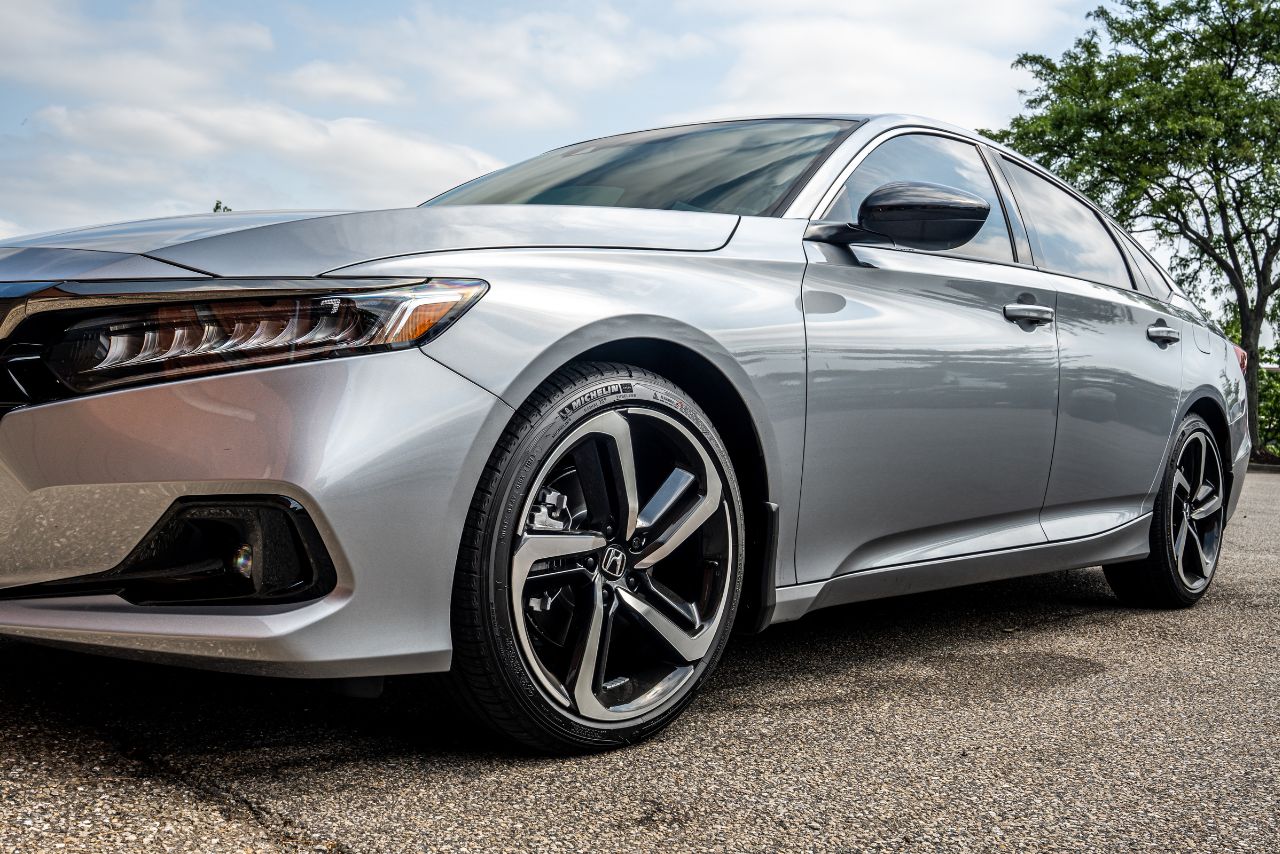Are Honda Civics Front Wheel Drive? Yes, Honda Civics are front wheel drive vehicles. Since its debut in 1972, the Civic has been known to be a practical, reliable, and fuel-efficient car.
The vehicle has come a long way in its advancement technologically and mechanically while still retaining its front wheel drive configuration.
Honda Civics with front wheel drive offer many advantages over other drivetrain configurations.
Front wheel drive vehicles typically offer better fuel economy, better traction on wet or slippery roads, and are easier and less expensive to maintain.
Additionally, the compact design of the engine and transmission in a front wheel drive configuration could yield more passenger room, which is a bonus for car buyers who seek spacious cars.
Yes, Honda Civics are front-wheel drive vehicles. Front-wheel drive means that power is primarily sent to the front wheels, which provide traction and propel the vehicle forward. This configuration is common among compact and midsize cars, including the Honda Civic.
Table of contents
Overview of Honda Civics:
Honda Civics are popular compact cars that have been around since 1972. These vehicles are known for their reliability, fuel efficiency, and affordability. Today, they are one of the most popular models in the Honda lineup.
Body Styles:
Over the years, Honda Civics have been available in several body styles, including sedan, coupe, hatchback, and wagon. The current model year, 2023, is only available in a sedan or coupe.
Engine Options:
Honda Civics offer a range of engines, including:
- 2.0L 4-cylinder engine (standard)
- 1.5L turbocharged 4-cylinder engine (optional)
- Type R model has a 2.0L turbocharged 4-cylinder engine
Fuel Economy:
Fuel economy is one of the Honda Civic’s strengths. Here is a table with the EPA estimated fuel economy for each body style and engine combination for the 2023 model year:
| Body Style | Engine | MPG City | MPG Highway | MPG Combined |
|---|---|---|---|---|
| Sedan | 2.0L | 30 | 38 | 33 |
| Sedan | 1.5L | 32 | 42 | 36 |
| Coupe | 2.0L | 30 | 38 | 33 |
| Coupe | 1.5L | 29 | 36 | 32 |
Front Wheel Drive or All-Wheel Drive?
Honda Civics are front-wheel drive vehicles. All-wheel drive is not currently offered in the Civic lineup.
Overall, Honda Civics are reliable, efficient, and affordable cars that have stood the test of time. They offer a versatile range of options for buyers looking for a compact car.
Types of Honda Civic Drivetrains:
Honda Civics have been manufactured with various types of drivetrains over the years, including Front-Wheel Drive (FWD), Rear-Wheel Drive (RWD), and All-Wheel Drive (AWD).
However, the Honda Civic is predominantly a FWD car. Below we discuss the different types of Honda Civic drivetrains.
Front-Wheel Drive (FWD):

The Honda Civic is primarily a FWD car. This means that the power from the engine is transmitted to the front wheels only. FWD cars are popular choices for many drivers because:
- They tend to have better fuel economy
- They have lower upfront costs compared to RWD and AWD cars
- They are generally more reliable
Rear-Wheel Drive (RWD):
RWD was an option for some Honda Civics earlier in production, but it is no longer available. RWD cars transmit power to the rear wheels, making them better for acceleration and handling.
However, RWD cars tend to have lower fuel efficiency and can be more expensive to maintain.
All-Wheel Drive (AWD)
AWD drivetrains have been introduced in some Honda Civic models, but they are not as common as FWD. AWD cars send power to all four wheels, giving them better traction and handling in various weather conditions.
However, AWD cars tend to have lower fuel efficiency and higher upfront cost compared to FWD cars.
| Drivetrain Type | Key Features |
|---|---|
| FWD | Better fuel economy, lower upfront cost, more reliable |
| RWD | Better acceleration and handling, lower fuel efficiency, more expensive maintenance |
| AWD | Better traction and handling in various weather conditions, lower fuel efficiency, higher upfront cost |
The Honda Civic is predominantly a FWD car, but RWD and AWD have been available in some models.
Each drivetrain type has its own advantages and disadvantages, making it important to consider your needs before selecting a drivetrain type for your Honda Civic.
Front-Wheel Drive in Honda Civics:

Honda Civics are one of the most popular small cars on the market, known for their reliability and fuel efficiency. One of the key features that makes Civics stand out is their front-wheel drive system.
Here are some essential details about how front-wheel drive works in Honda Civics:
- Honda Civics use a transversely-mounted engine, which means the engine sits across the car rather than lengthwise.
- The engine is connected to a transaxle, which combines the transmission and differential into a single component.
- Front-wheel drive means that the power from the engine is transmitted to the wheels located in the front of the car.
There are several benefits to front-wheel drive:
- Improved traction: The weight of the engine over the front wheels gives the car better traction, especially in slippery conditions.
- Better fuel efficiency: The front-wheel drive system is simpler and lighter than all-wheel or rear-wheel drive, resulting in improved fuel economy.
- More interior space: By placing the engine and transmission over the front wheels, Honda is able to maximize space in the passenger compartment.
While front-wheel drive is generally considered less desirable for performance driving, Honda has made significant advancements with the Civic’s suspension system to improve handling and stability.
Additionally, many drivers prefer front-wheel drive for its predictable and safe handling characteristics.
| Fact | Data/Stat |
|---|---|
| Transversely-mounted engine | Engine sits across the car rather than lengthwise |
| 1.5L Engine | Standard engine size |
| 30 city/ 38 highway MPG | Fuel Efficiency |
| Improved traction | Advantage of front-wheel drive |
| Better fuel efficiency | Benefit of front-wheel drive |
| More interior space | Benefit of front-wheel drive |
In short, Honda Civics are indeed front-wheel drive cars. While not as performance-oriented as some sports cars, the front-wheel drive system provides excellent traction and fuel efficiency, making it a popular choice among drivers who prioritize reliability and practicality.
Benefits of Front-Wheel Drive:
Front-wheel drive cars like the Honda Civic have several advantages over rear-wheel drive cars. In this section, we will highlight some of the benefits.
1. Better Traction in Snow and Rain:
Front-wheel drive cars have better stability and traction on slippery surfaces. Since the weight of the engine is over the driving wheels, the car can better grab onto the road.
This makes the car more controllable and responsive in poor weather conditions.
2. More Efficient Use of Space:
Front-wheel drive cars usually have a more compact powertrain due to the engine being located transversely (sideways).
This allows for more cabin space and a larger trunk. Additionally, having the engine in front of the front axle helps to balance out the car’s weight distribution, which can improve handling.
3. Lower Production Costs:
Front-wheel drive cars are generally cheaper to produce compared to rear-wheel drive cars because they require fewer components. This can lead to a lower sticker price for the consumer.
| Benefit | Explanation |
|---|---|
| Better Traction | Front wheel drive cars have better stability and traction on slippery surfaces due to weight distribution. |
| More Efficient Use of Space | Front wheel drive cars usually have a more compact powertrain which allows for more passenger and trunk space. |
| Lower Production Costs | Front wheel drive cars are generally cheaper to produce compared to rear-wheel drive cars due to simplified designs. |
Overall, front-wheel drive cars like the Honda Civic have several advantages that make them a popular choice for car buyers.
Performance of Front-Wheel Drive Honda Civics:
Front-wheel drive Honda Civics are known for their impressive performance. Here are some of the key features and statistics that make them stand out:
1. Fuel Efficiency
Honda Civics are known for their excellent gas mileage, particularly when it comes to city driving.
Front-wheel drive Civics often get even better fuel efficiency than their rear-wheel drive counterparts, thanks to a lighter weight and more efficient drivetrain.
2. Handling
Front-wheel drive Civics are known for their excellent handling, thanks to their front-mounted engine and front-wheel drivetrain.
This configuration provides greater control and stability when cornering, especially in wet or slippery conditions.
3. Acceleration
Front-wheel drive Civics can also be impressively quick off the line, thanks to their front-wheel drivetrain.
This configuration allows for better weight distribution and traction, which can translate to improved acceleration times.
4. Top Speed
The top speed for front-wheel drive Honda Civics is around 120 miles per hour. The specific top speed can vary depending on the model, year, and modifications made.
| Model | Top Speed (mph) |
|---|---|
| 2021 Civic Si | 137 |
| 2021 Civic R | 169 |
5. Braking
Front-wheel drive Civics also have strong braking systems, which are essential for safety on the road.
Honda Civics have been rated highly in brake tests, thanks to their well-engineered brake systems.
Overall, front-wheel drive Honda Civics are known for their impressive performance on the road. Whether you’re looking for a fuel-efficient city car or a sporty, high-performance vehicle, the Honda Civic has you covered.
Hybrid and Electric Honda Civics:
Honda released a hybrid version of the Civic in 2024 model, the first model in its line of hybrid vehicles.
The Honda Civic Hybrid features both a gasoline engine and an electric motor, making it a hybrid-electric vehicle (HEV).
The hybrid Civic uses a continuously variable transmission (CVT) which allows the engine and electric motor to work in tandem, thus maximizing fuel efficiency.
The battery pack used in the hybrid was initially a nickel-metal hybrid battery but was later replaced with a Lithium-ion battery.
The electric version of the Honda Civic, known as the Honda Civic EV, going to be introduce in 2024.
It was only available for lease and was primarily designed for California market. It featured a 20-kilowatt-hour battery pack, which gave the car a range of around 80 miles per charge.
| Model | Battery Pack Type | Range |
|---|---|---|
| Honda Civic Hybrid | Lithium-ion | 52 mpg city, 45 mpg highway |
| Honda Civic EV | Lithium-ion | 80 miles |
The newer models of Honda Civic hybrids come with improved fuel efficiency and a more powerful battery.
The battery pack was upgraded to a 1.3 kWh Lithium-ion battery. The Honda Civic Hybrid now gets an impressive fuel efficiency of 52 mpg city and 45 mpg highway.
Overall, by offering the hybrid and electric iterations of the Honda Civic, Honda has further cemented the car’s position as one of the most popular eco-friendly vehicles on the market.
All-Wheel Drive Options in Honda Civics:
Honda Civics are known for their reliability, fuel efficiency, and easy-to-drive nature. However, some drivers may desire the added traction and control of all-wheel drive (AWD).
While the majority of Honda Civics are front-wheel drive (FWD), there are a few AWD options available.
Honda Civic Type R:
The Honda Civic Type R is a high-performance variant with impressive horsepower and a track-tuned suspension. Unlike other Civics, the Type R uses AWD to put down its power and keep the car planted to the road.
This AWD system is unique to the Type R, with power being sent primarily to the front wheels but capable of sending up to 70% of torque to the rear wheels when needed.
Honda Civic i-CTDi:
The Honda Civic i-CTDi is a diesel-powered variant not sold in the US, but worth mentioning because of its AWD system.
Unlike the Type R, the i-CTDi has a full-time AWD system that splits power evenly between the front and rear wheels.
This system provides additional traction in a variety of conditions, making it a popular choice for drivers in Europe and other markets.
Honda Civic Real Time 4WD:
The Honda Civic Real Time 4WD was offered in the US in the late 1980s and early 1990s. This system was a full-time AWD system that used a viscous coupling to send power to the rear wheels when the front wheels lost traction.
While this system was well-liked by many drivers, it was eventually replaced by front-wheel drive models with improved traction control systems.
| Model | Type of AWD | Drive |
|---|---|---|
| Type R | On-demand (front-biased) | AWD |
| i-CTDi | Full-time | AWD |
| Real Time 4WD | Full-time | AWD |
Overall, while the majority of Honda Civics are front-wheel drive, there are a few AWD options available. The Type R uses an on-demand system, while the i-CTDi and Real Time 4WD use full-time systems.
Depending on your driving needs and preferences, an AWD Honda Civic may be worth considering.
Comparison with other Honda Models:
When it comes to front-wheel drive Honda vehicles, the Civic is not alone. There are several other Honda models that also feature front-wheel drive, including the Accord, HR-V, and Fit. Here’s a closer look at how these models compare to the Civic:
| Model | Front-Wheel Drive | Engine Options | Transmission Options |
|---|---|---|---|
| Civic | Yes | 2.0L 4-cylinder or 1.5L turbocharged 4-cylinder | 6-speed manual or CVT |
| Accord | Yes | 1.5L turbocharged 4-cylinder or 2.0L turbocharged 4-cylinder | 6-speed manual, 10-speed automatic, or CVT |
| HR-V | Yes | 1.8L 4-cylinder | 6-speed manual or CVT |
| Fit | Yes | 1.5L 4-cylinder | 6-speed manual or CVT |
Accord vs. Civic:
The Accord is a larger sedan compared to the Civic, but it also offers more engine options, including a 2.0L turbocharged 4-cylinder option, which the Civic doesn’t have.
The Accord also has more transmission options, including a 10-speed automatic, making it a more versatile vehicle for a wider range of driving needs.
HR-V vs. Civic:
While the HR-V is a small crossover SUV, it shares many similarities with the Civic, including front-wheel drive and a 1.8L 4-cylinder engine option.
However, the HR-V also has more cargo space and a higher seating position, making it a more practical choice for those who need more room and versatility.
Fit vs. Civic:
The Fit is the smallest of the Honda models with front-wheel drive, but it still offers plenty of practicality and efficiency.
With a 1.5L 4-cylinder engine and available 6-speed manual transmission, the Fit is a fun-to-drive hatchback that’s perfect for city driving and tight parking spaces.
However, it doesn’t offer the same level of refinement and interior space as the larger Civic.
Importance of Front-Wheel Drive in Honda Civics:
The Honda Civic has been one of the most popular compact cars on the market for years, and one of the reasons for that is its front-wheel-drive system. Here are some of the key advantages of front-wheel drive in Honda Civics:
- Better traction: Front-wheel drive provides better traction than rear-wheel drive in slippery conditions, such as snow or rain. The front wheels pull the car forward instead of pushing it, which gives better traction in slippery conditions.
- Better fuel efficiency: Front-wheel drive systems are generally lighter and more compact than rear-wheel drive systems. This leads to better fuel efficiency and lower emissions.
- Better handling: Front-wheel drive cars have a more natural turning radius than rear-wheel drive cars. This leads to better handling and maneuverability in tight spaces.
- More interior space: Front-wheel drive cars have a more compact powertrain that allows for more interior space. This means that passengers in a Honda Civic can enjoy more legroom and headroom than they would in a rear-wheel drive car of similar size.
The front-wheel-drive system is a key part of what makes the Honda Civic such a popular and versatile compact car. It provides better traction, improved fuel efficiency, better handling, and more interior space.
Whether you’re commuting to work, running errands, or embarking on a road trip, the front-wheel drive system in the Honda Civic helps provide a safe and comfortable ride.
| Advantage | Explanation |
|---|---|
| Better traction | Front wheels pull the car forward instead of pushing, giving better traction in slippery conditions. |
| Better fuel efficiency | Front-wheel drive systems are generally lighter and more compact, leading to better fuel efficiency. |
| Better handling | Front-wheel drive cars have a more natural turning radius, leading to better handling and maneuverability. |
| More interior space | Front-wheel drive cars have a more compact powertrain, allowing for more interior space for passengers. |
Conclusion and final thoughts 💭
After thorough research, it is clear that Honda Civics are front-wheel drive vehicles. This feature is what has made the Civic a popular car over the years.
Its efficient front-wheel drive system allows for better fuel economy, more responsive handling, and smoother driving experience.
There are many reasons why car buyers choose front-wheel drive vehicles like the Honda Civic.
One main reason is that it provides better traction on slippery or wet roads, making it a safer choice for drivers. Moreover, front-wheel drive cars are typically more affordable and easier to maintain compared to rear-wheel or all-wheel drive vehicles.
In conclusion, Honda Civics are front-wheel drive vehicles and have been for several decades.
This is just one of the many features that make the Civic a great choice for car buyers. With its fuel efficiency, reliability, and affordability, the Civic remains a popular choice in the compact car market.
Latest Posts:
- Can WD-40 Remove Scratches on Cars? (Hint: Yes, but…)
- Can You Use a Drill to Polish Your Car? (We Tried it Out!)
- Should You Cover Car Scratches With Stickers? (REVEALED!)
- Buick Service Stabilitrak: (Causes & 100% Guaranteed Fix!)
- Common Holden Trax Problems (Causes & 100% Proven Fixes!)
- Jeep Commander Transmission Over Temp: (Guaranteed Fix!)












Leave a Reply